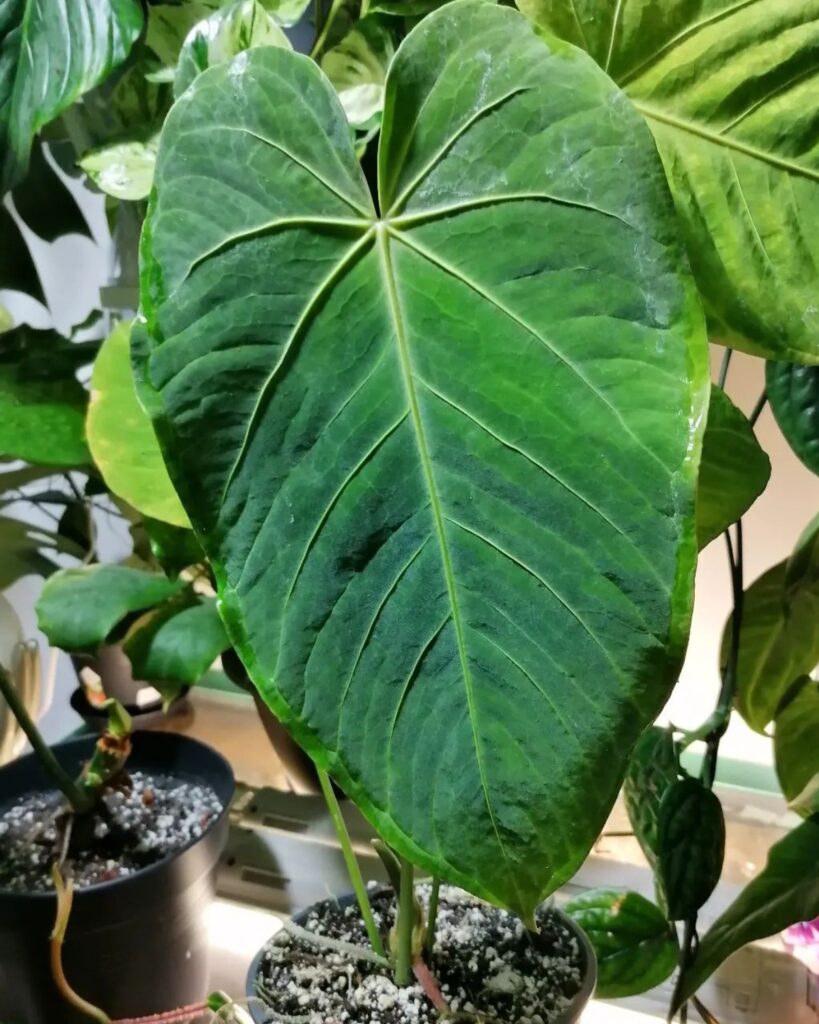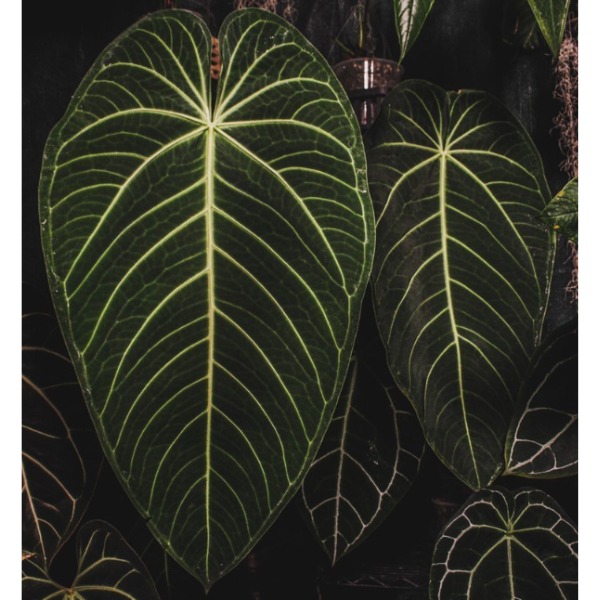Craving an anthurium with those dramatic heart-shaped leaves that scream ‘Look at me!’? Meet the Anthurium Waterburyanum – the showstopper you didn’t know you needed in your plant collection!
Anthurium waterburyanum is trickier to grow than its popular heart-shaped counterparts, like the magnificum or crystallinum. This added challenge might explain its rarity in indoor plant collections. But fear not; we’re here to guide you through it.

About Anthurium Waterburyanum
Anthurium waterburyanum belongs to the Araceae family and is native to Ecuador. This hemiepiphytic anthurium boasts large, ovate, heart-shaped leaves that can grow massive.
Unlike the more famous anthuriums, its veining is not as prominent, but the size of the deep green velvety leaves will not disappoint. It makes a stunning addition to any indoor jungle.
Anthurium waterburyanum is named after the late Bette Waterbury, the co-founder and the first president of the International Aroid Society, a nonprofit dedicated to promoting aroid education, research, and horticulture.
Anthurium Waterburyanum Care Requirements
Anthurium waterburyanum is a somewhat difficult anthurium to grow, in my experience. It takes a long time to acclimate and pushes new leaves slower than other species. With that said, below are the care requirements for optimal growth.
Soil
Anthurium waterburyanum is a hemiepiphyte. Hemiephyphytic plants start as epiphytes on other plants but eventually send roots to the ground, often becoming independent of their host. This means providing well-draining, airy soil is crucial.
A mix of pine bark, perlite, and coco peat provides the ideal growing medium. This combination allows for both moisture retention and adequate aeration, mimicking the conditions of its native rainforest habitat.
For a thorough discussion of what it means to have the right potting mix and simple recipe, check out my guide on anthurium potting mix.
Lighting
Proper lighting is essential for the health and growth of your Anthurium waterburyanum. Bright, indirect light is the key.
Place your plant near a window with filtered sunlight in an indoor setting. An excellent way to do this is by using white mesh-like curtains to filter out the harsh glare of the sunlight, which can scorch delicate leaves.
If natural light is insufficient, use grow lights. Check out my guide on essential light requirements for anthuriums.
Watering
Maintaining a proper moisture level will keep your Anthurium waterburyanum thriving. Ensure the soil is evenly moist throughout but not overly damp for prolonged periods.
Water thoroughly, but let it dry out slightly in between waterings. Depending on the density of your potting mix, container size, and ambient temperature, the watering schedule might vary throughout the year.
Over time, you will know when it is time to water. For more nuanced information related to the watering needs of anthurium, read ‘Water like a Pro: An Essential Guide to Anthurium Watering.’
Humidity
As with any houseplant care, imitating the plant’s natural environment is the best way to go. You can aim for humidity levels between 60% to 80%.
To maintain adequate humidity, you can use a humidifier or place the plant in a controlled environment, such as a grow tent or a cabinet fitted with grow lights and a humidifier.
Through personal experience, I find that simply placing your plants beside each other creates a mini-humid environment. Be careful with misting the leaves! It won’t do much to increase humidity but can induce a disease.
These velvet anthurium plants are easily susceptible to fungal and bacterial infections that can ruin those perfect leaves. This is especially true if your indoor space doesn’t have adequate airflow.
Temperature
Anthurium Waterburyanum thrives in a tropical environment, having a temperature range between 65°F to 80°F (18°C to 27°C). As such, this plant does not do well in colder climates. Avoid exposure to fluctuating temperatures and cold drafts, which can shock the plant and hinder its growth.
Fertilizing
Supplementing a balanced fertilizer is essential for promoting optimal growth. During active growth, apply fertilizer at least once a week during watering. A concentration below the recommended dosage is always a safe way to avoid burning the roots.
Using vermicast as a topsoil is also a good way to fertilize your Anthurium waterburyanum naturally.
Pests & Diseases
Keep an eye out for common household pests, such as thrips, spider mites, and scale, which can damage the leaves of Anthuriums. Regularly check the front and back sides of the leaves for any signs of pests or noticeable damage.
Fungal or bacterial diseases are also common, usually due to improper watering or inadequate airflow.
Sought-after Anthurium Waterburyanum Hybrids
Avid aroid enthusiasts have crossed Anthurium waterberyanum with other species, resulting in hybrids that merge their distinctive traits to produce diverse leaf shapes and growth patterns.
The most well-known cross includes Queen Anthurium Warocqueanum.
Anthurium ‘Warocqueanum x Waterburyanum’

Anthurium ‘Warocqueanum x Waterburyanum’ is a stunning hybrid. It has slightly elongated leaves and more pronounced veining inherited from Anthurium warocqueanum while retaining a broader leaf shape from the waterburyanum.
Not recommended for beginners!
The two parents make for a fussy hybrid. Hats off to those who can grow it well. But if you do, you’ll be rewarded with gorgeous velvet leaves.
Other interesting hybrids are Anthurium Waterburyanum x Magnificum and Anthurium Waterburyanum x Clarinervium.
So, there it is– by providing the proper care and attention, Anthurium waterburyanum is a regal and captivating plant that can give your indoor space an exotic jungle vibe.

